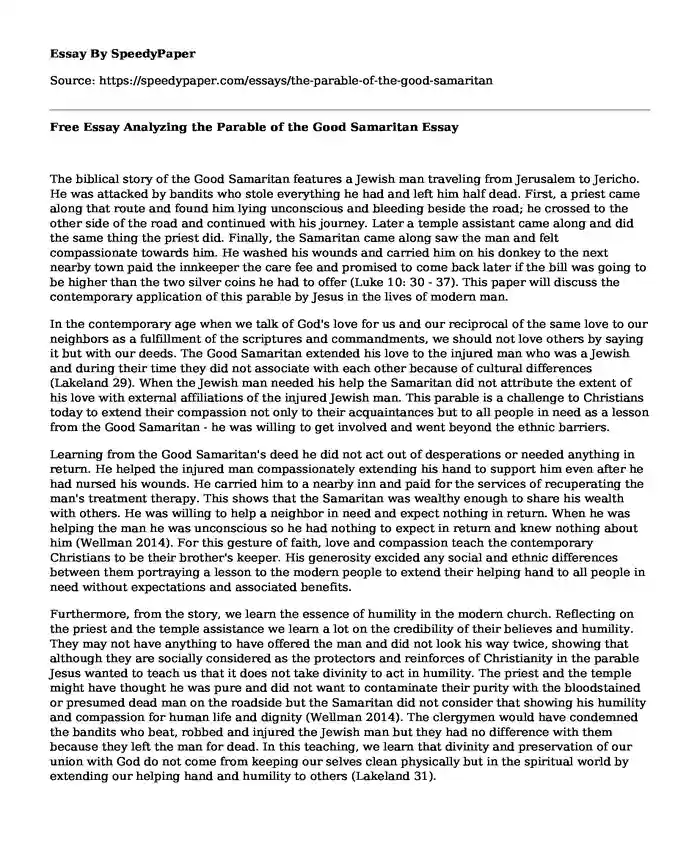
| Type of paper: | Essay |
| Categories: | Christianity Bible |
| Pages: | 3 |
| Wordcount: | 753 words |
The biblical story of the Good Samaritan features a Jewish man traveling from Jerusalem to Jericho. He was attacked by bandits who stole everything he had and left him half dead. First, a priest came along that route and found him lying unconscious and bleeding beside the road; he crossed to the other side of the road and continued with his journey. Later a temple assistant came along and did the same thing the priest did. Finally, the Samaritan came along saw the man and felt compassionate towards him. He washed his wounds and carried him on his donkey to the next nearby town paid the innkeeper the care fee and promised to come back later if the bill was going to be higher than the two silver coins he had to offer (Luke 10: 30 - 37). This paper will discuss the contemporary application of this parable by Jesus in the lives of modern man.
In the contemporary age when we talk of God's love for us and our reciprocal of the same love to our neighbors as a fulfillment of the scriptures and commandments, we should not love others by saying it but with our deeds. The Good Samaritan extended his love to the injured man who was a Jewish and during their time they did not associate with each other because of cultural differences (Lakeland 29). When the Jewish man needed his help the Samaritan did not attribute the extent of his love with external affiliations of the injured Jewish man. This parable is a challenge to Christians today to extend their compassion not only to their acquaintances but to all people in need as a lesson from the Good Samaritan - he was willing to get involved and went beyond the ethnic barriers.
Learning from the Good Samaritan's deed he did not act out of desperations or needed anything in return. He helped the injured man compassionately extending his hand to support him even after he had nursed his wounds. He carried him to a nearby inn and paid for the services of recuperating the man's treatment therapy. This shows that the Samaritan was wealthy enough to share his wealth with others. He was willing to help a neighbor in need and expect nothing in return. When he was helping the man he was unconscious so he had nothing to expect in return and knew nothing about him (Wellman 2014). For this gesture of faith, love and compassion teach the contemporary Christians to be their brother's keeper. His generosity excided any social and ethnic differences between them portraying a lesson to the modern people to extend their helping hand to all people in need without expectations and associated benefits.
Furthermore, from the story, we learn the essence of humility in the modern church. Reflecting on the priest and the temple assistance we learn a lot on the credibility of their believes and humility. They may not have anything to have offered the man and did not look his way twice, showing that although they are socially considered as the protectors and reinforces of Christianity in the parable Jesus wanted to teach us that it does not take divinity to act in humility. The priest and the temple might have thought he was pure and did not want to contaminate their purity with the bloodstained or presumed dead man on the roadside but the Samaritan did not consider that showing his humility and compassion for human life and dignity (Wellman 2014). The clergymen would have condemned the bandits who beat, robbed and injured the Jewish man but they had no difference with them because they left the man for dead. In this teaching, we learn that divinity and preservation of our union with God do not come from keeping our selves clean physically but in the spiritual world by extending our helping hand and humility to others (Lakeland 31).
In conclusion, the parable of the Good Samaritan plays a significant reflection to the contemporary Christian life as a point of reference to measure our definition of kindness, humility, compassion as well as a love for God and fellow men. It is through the parable that we derive the lessons to show how out Christianity can be put to test.
Works cited
Lakeland, Paul. Like a good neighbor: The lessons of the Good Samaritan. The issue of U.S. Catholic, 2012 Vol. 77, No. 10, pages 28-31.
The Bible Luke 10: 30 - 37 NLT
Wellman, Jack. Blind Chance or Intelligent Design, Christian Crier, 2014. Available at: http://www.patheos.com/blogs/christiancrier/2014/04/21/parable-of-the-good-samaritan-meaning-summary-and-commentary/
Cite this page
Free Essay Analyzing the Parable of the Good Samaritan. (2022, Jul 25). Retrieved from https://speedypaper.com/essays/the-parable-of-the-good-samaritan
Request Removal
If you are the original author of this essay and no longer wish to have it published on the SpeedyPaper website, please click below to request its removal:
- Free Essay on The Lovesong of J. Alfred Prufrock Analysis
- Free Essay about Phoenix Advertising Agency
- Free Essay Sample on Search Analytics
- Gross Income: Concepts and Inclusions Summary, Free Essay for Students
- Essay Sample: Global Warming and Its Causes
- The Concept of Global Environment and the Changes Seen Today. Essay Sample
- Free Essay. Gambling Increases the City's Revenue Although It Should Not Get Encouraged
Popular categories




